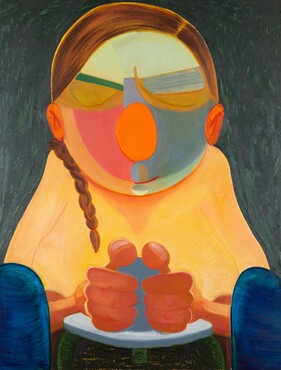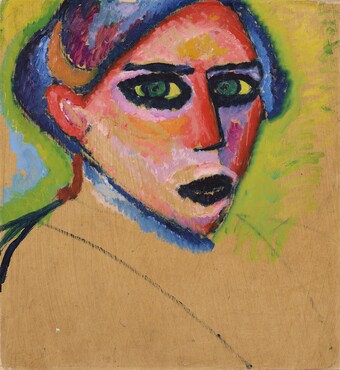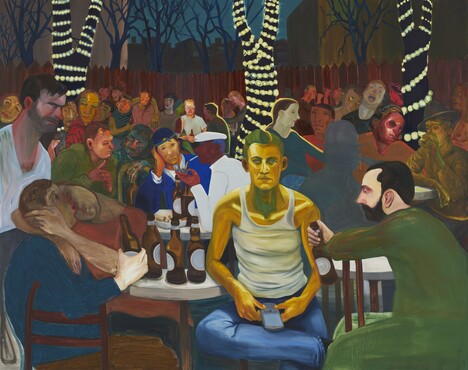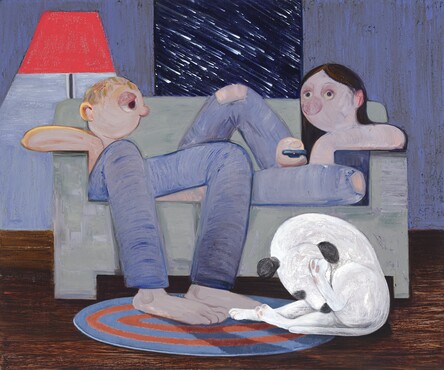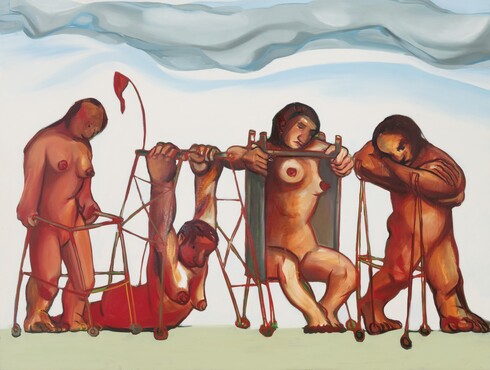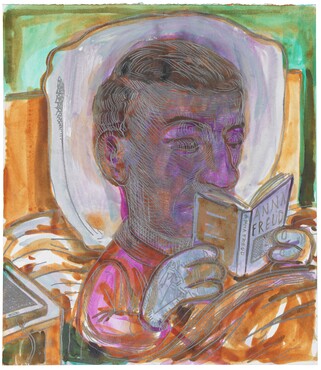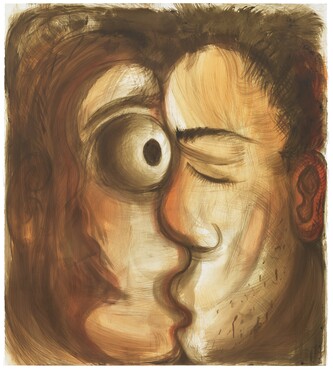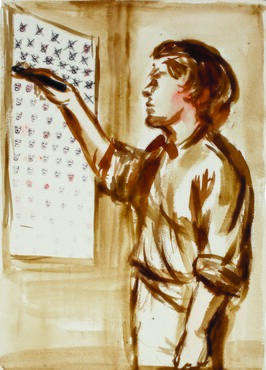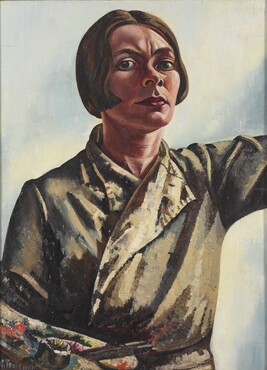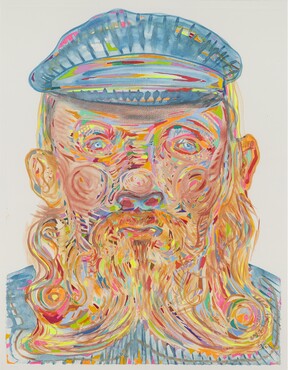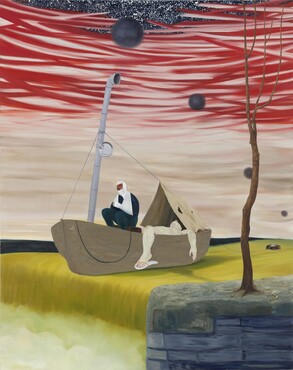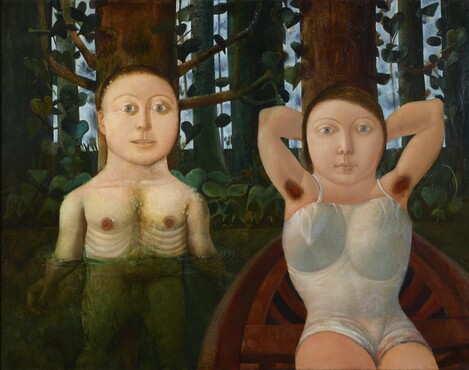Ontdek de collectie
Kunstmuseum Den Haag has a treasure chamber of over 160.000 pieces of art. Here we work on making the highlights from this collection available online.
Nicole Eisenman
& the moderns
Defiant, socially critical narratives presented with humour and recognisable elements from art history and popular culture, in a whole range of colours: that defines the work of Nicole Eisenman (they/them*). For the first time in almost 30 years, a retrospective of the work of one of today’s leading artists is about to open in the Netherlands. During those 30 years, the New York artist has built up a wide-ranging and iconic body of work. This winter, 70 artworks by Nicole Eisenman will be on show at Kunstmuseum Den Haag. Their vibrant paintings and drawings, exploring themes like humanity, queerness and society, will be shown alongside masterpieces by modern artists like Paula Modersohn-Becker and Edvard Munch, who in their day engaged with the same subjects and struggled with the same issues, or who held views that Eisenman actively opposes. The modern artworks on display, from the collections of Kunstmuseum Den Haag, Kunsthalle Bielefeld (Germany) and the Aargauer Kunsthaus (Switzerland), have been selected by Eisenman themself. Nicole Eisenman & the Moderns is a collaborative project developed and hosted by these institutions, plus the Fondation Vincent van Gogh in Arles (France). The show at Kunstmuseum Den Haag will be the last opportunity to see this unique exhibition.
The work of Nicole Eisenman
Nicole Eisenman (b. 1965, Verdun, France) makes paintings, drawings and installations that address issues like gender, racism and economic inequality, and explore themes like the ever-present fear of the future, the digital age and our dependence on technology. At the same time, Eisenman’s art also employs humour to question the society they and we live in and the challenges it confronts us with, using familiar and colourful elements of popular culture and media. Modern art history also plays a major role in their work. As well as having mastered the painting techniques used by their predecessors, Eisenman also includes many motifs from their work to create exuberant, ingenious paintings and drawings. Eisenman’s work represents contemporary painting like no other.
In search of the ideal community
Eisenman’s work featuring the beer gardens where New Yorkers meet to eat and drink together combines many of the subjects they explore in their art. Take Beer Garden with Ash/AK (2009), for example, in which the characters – mostly fictional, and of unclear gender and race, but often Eisenman themself and their friends – seem a little lost, in search of connection, a community. Though they sit in small groups, they all appear to be isolated and introverted, aimlessly staring at their phone. Here, Eisenman reflects on today’s society, presenting the characters as the product of our age. At the same time, Eisenman has not given up the quest for the ideal community, a utopian society, as also becomes clear in a series of drawings made during a weekend at the beach and featuring artists, writers, musicians and lovers spending some peaceful and harmonious time together as a temporary creative community. The same applies to the diptych Mining I and Mining II, in which a group of women seem to have created a self-sufficient community.
Another highlight in the exhibition is the diptych Progress: Real and Imagined (2006). This painting is more than nine metres long. The left panel shows Eisenman themself in a small studio on a boat, making art amidst the deluge. The entire studio is full of Eisenman’s own work, and there is a large bunch of flowers, used to showcase their virtuosity as a painter. While the left panel depicts Eisenman’s struggle with the challenges of being an artist, on the right they give their imagination free rein, presenting a dream world containing an endless range of elements for the viewer to discover. Hunters with a pack of white dogs with dark spots (a reference to living as a person in a binary world: wishing to be mixed and hybrid, in terms of both race and queer identity, all the black-and-white), a comic strip character hiding in a cave, people flying around and a group of other people rendered in the style of Hiëronymus Bosch, in a scene with only women in the starring role. This surrealist landscape lies somewhere between dream and reality, as Eisenman explores the potential of painting with keen sense of humour.
The moderns
The themes Eisenman explores are often the same as those explored by the early 20th century’s modern artists. They include the search for one’s own identity in the face of binary gender roles and social conventions, the individual in an anonymous mass society, and political and technological developments and their impact on personal lives. In this exhibition, Eisenman’s art will be shown alongside the work of modern artists like Paula Modersohn-Becker, Vincent van Gogh, Max Beckmann, Käthe Kollwitz and Alexej von Jawlensky. The show will also include work by Dutch artists such as Charley Toorop and Co Westerik. Like Eisenman, the moderns had a critical attitude to society, themselves and other artists, and they sought alternative, utopian ways of living. The unique juxtaposition of Eisenman’s work with that of well-known and lesser-known modern artists in this exhibition will shed new light on these modern artworks, and vice versa. The work of Eisenman has never before been seen in this context.
The exhibition
The exhibition will feature some 70 paintings and drawings by Eisenman produced since 1990. Most of them come from private collections. The 40 works by modern artists were chosen by Eisenman from the collections of Kunstmuseum Den Haag, Kunsthalle Bielefeld and the Aargauer Kunsthaus. These, and all the paintings and drawings, will be grouped into five themes spread across ten galleries at Kunstmuseum Den Haag, where they will be on view to the public from 12 November 2022 to 12 February 2023.
About Nicole Eisenman
Born in Verdun, France, in 1965, Nicole Eisenman grew up in New York. They studied Fine Art at the Rhode Island School of Design, graduating in 1987. While still an undergraduate, Eisenman spent a year in Rome, where they encountered the art of the Renaissance. After graduating, Eisenman returned to New York and started experimenting with various mediums, from painting, printmaking and sculpture to installations and video. It was not long before their work was shown in a number of exhibitions in the US and abroad.
In 2013 Eisenman was awarded the Carnegie Prize, followed by the prestigious MacArthur Fellowship in 2015. They were inducted into the American Academy of Arts and Letters in 2018. Their work was shown at the Venice Biennale and The Whitney Biennal in 2019. Eisenman has previously had solo shows at the Astrup Fearnley Museum of Modern Art, Oslo (2021), The Contemporary Austin (2020) and the Staatliche Kunsthalle Baden-Baden (2018).
Nicole Eisenman lives and works in New York.
*Nicole Eisenman uses the personal pronouns they/them. Kunstmuseum Den Haag has decided to use the pronouns they/them when referring to people who identify as gender non-conforming.

